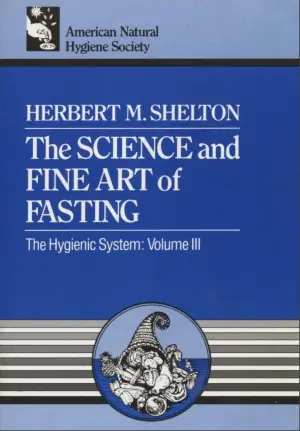Fasting - Its Science And Art

- Meaning of fasting
- Fasting is not starving
- Chemical and organic changes during fasting
- Repair of organs and tissues
- Rejuvenesence through fasting
- Gain and loss of strength and weight
- Can fasting cure diseases?
Click here to read PDF Book
Comments
Excerpt
Excerpt
Fasting is Not Starving
CHAPTER VI
The word starvation is derived from the Old English steorfan, meaning to die. Today it is used almost wholly to designate death from lack
hen we mention fasting to the average person and even the average physician, he immediately pictures to himself, the dire consequences that he thinks must inevitably result from going for even a few days without food. To him to fast is to starve that is, die Physiologists, physicians, biologists arid other professionals, who should know better and who should be more precise in their use of terms, are also guilty of confusing the terms fasting and starvation. Members of the 'learned professions' habitually employ the two terms synony mously, thus helping to perpetuate the delusion. This is not only true, but I have found, in discussing the matter with physiologists and others, that they are short-sightedly incapable of making a distinction between the two processes.
The fear of fasting is kept alive by the press, which, ever so often carries the story of somebody dying while fasting, and invariably death is attributed to starvation. These deaths are presented as 'horrible examples' of the 'evils of fasting.' How rare are these deaths! But it would be enlightening if we could have all the details of each of these deaths. No doubt, we would find that most of them are not due to abstinence from food at all. Most of these deaths have been due to irreparable damage to some vital organ (organic disease), an occasional one may have been due to pushing the period of abstinence beyond the fasting period, a few have been due to injudicious breaking of the fast, some of them have been due to drugs. But every day people die from unnecessary and 'unsuccessful' operations and the press keeps quiet. Every day people die from drugging and the editors and newsmen ignore such deaths. Fasting is their target.
The uninformed physician imagines that the blood and the vital or functioning tissues of the body begin to break down the moment food is withdrawn; that organic destruction sets in immediately and that every day the fast is prolonged means a greater destruction of the vital tissues. That this idea is false will become apparent presently.
In previous chapters it was shown that the body, at all times, has stored within itself reserves of food sufficient to last for considerable
time in the event of scarcity of food or of sickness, when food cannot be digested. We saw how the body feeds upon this food reserve and how the vital tissues of the body feed upon the least essential, so that even if actual starvation occurs, there is almost no damage to the vital organs.
So long as the body's food reserves last, the individual abstaining from food is fasting. When this reserve has been consumed to the point where it is no longer able to sustain the functions of life, further abstinence becomes dangerous, starvation begins. It is only after this point is reached that any real damage is sustained by the vital organs and their functions. As a general rule, under proper conditions of environment, one may fast for weeks, and even months, before the starvation point is reached. 'It is perfectly true,' says Sinclair, 'that men have died of starvation in three or four days, but the starvation existed in their minds it was fright that killed them' (191 la, p. 333).
Laboratory workers describe destructive changes in the pancreas, supra-renal glands and other organs and glands of the body, as a result of starvation. But these changes occur after the period of fasting proper has been passed. The vital cells of the organs and glands-those doing the actual physical and chemical work of these organs-do not begin to break down until actual starvation begins.
Morgulis says: 'Apart from the purely pathological phenomena occurring in the terminal stages (the starvation period) of fasting, it should be mentioned that the histological peculiarities appearing in the very beginning of inanition are associated with changes in the colloidal condition of the protoplasm and are not at all degenerative in kind. The progressive atrophic changes coincident with inanition are simply due to the gradual withdrawal of metaplasmic inclusions which represent the nutritive reserves of the cells. The atrophic diminution of both cells and nuclei does not, therefore, present a pathological phenomenon either. Moreover, the morphological processes in in anition are not invariably destructive, cell proliferation going when the organism has been deprived of nourishment for a long time.'
This means that, except during the actual starvation period, the wasting of parts during a fast is the result of the using up of those portions of the protoplasm of the cells containing the products of their secretions and not of an actual destruction of the cell proper. The metaplasm is slowly used as the fast progresses, so that the size of the cells and, consequently, of the organ is gradually reduced, but there is no actual deterioration in structure of the cells, tissues and organs.
Dr. Morgulis makes the cautious, perhaps over-cautious, estimate that a fast which involves a body loss of ten to fifteen per cent is harmless and usually beneficial; and that the danger point in fasting
vhen from twenty-five to thirty per cent has been lost. He has had animals recover normal health after a weight loss of sixty per cent. We have seen the same thing in more than one man and woman.
A number of people have died of serious organic 'disease' while fasting, and autopsies have been performed in many of these. In every case there was still considerable subcutaneous fat, whereas, this is always entirely absent where death has been caused by starvation.
Except in a case or two where the heart had never sufficiently developed or where there was previous heart 'disease,' the heart was found to be normal in all cases; while in actual starvation, the heart is always contracted or markedly atrophied. The pancreas is little, if at all affected, in death during the fast, whereas in death from starvation, this gland is almost entirely absent. In these cases the blood was normal in amount with no anemia present; while in starvation, the relative blood volume is reduced and there is usually marked anemia.
In fasting the tongue remains coated, the breath offensive, the pulse and temperature sub-normal and hunger may disappear for days at a time.
Death may result at any time, feeding or fasting, due to the failure of some particular vital organ, which is so far destroyed that a fatal ending cannot be prevented by any means, but death from abstinence from food cannot occur until all possible nutritive material has been exhausted. 'True starvation begins,' says Sinclair, 'only when the body has been reduced to the skeleton and the viscera.'
Fortunately we are not left unprotected and unwarned in this matter. Before the danger point is reached an imperious demand for food will be made. We say, then, that so long as hunger is lacking, the patient is fasting; but after hunger returns, if he continues to abstain from food, he is starving. Besides the return of hunger, there are other indications that the body is ready to take food, as stated elsewhere.
Carrington has well summed up the matter in these words: 'Fasting is a scientific method of ridding the system of diseased tissue, and morbid matter, and is invariably accompanied by beneficial results. Starving is the deprivation of the tissues from nutriment which they require, and is invariably accompanied by disastrous consequences. The whole secret is this: fasting commences with the omission of the first meal and ends with the return of natural hunger, while starvation only begins with the return of natural hunger and terminates in death. Where the one ends the other begins. Whereas the latter process wastes the healthy tissues, emaciates the body, and depletes the vitality; the former process merely expels corrupt matter and useless fatty tissue, thereby elevating the energy, and eventually restoring the organism. that just balance we term health.'
Prof. Morgulis divides what he calls starvation, or inanition, into four periods 'each period comprising approximately one-fourth of the total loss in weight sustained at the time of death' (1923, p. 132).
The first of these periods 'in every complete inanition,' (by 'complete inanition' is meant abstinence from all food until death occurs) is a 'transition from the condition of adequate feeding to the basal metabolism of fasting'-'the organism is readjusting itself from the prefasting metabolic level to the level of the true physiological minimum characteristic for the particular individual.'

English Topics
Spiritual books
Click on any topic to open
- 30 Adhyatma Ramayana - English Translation
- 29 Kathakali - The Dance Of Kerala
- 28 Varanasi Down the Ages: Tracing the Evolution of India's Spiritual Capital
- 27 Vedas With Meaning
- 26 Valmiki Ramayanam
- 25 Sapthagiri - January - 2019
- 24 Vedas On Marriage - Emancipation Of Woman
- 22 Scientific Hindu
- 21 What Is Hinduism?
- 20 Antyeshti - Death Rituals
Please wait while the audio list loads..
30
Ganapathy
Shiva
Hanuman
Devi
Vishnu Sahasranama
Mahabharatam
Practical Wisdom
Yoga Vasishta
Vedas
Rituals
Rare Topics
Devi Mahatmyam
Glory of Venkatesha
Shani Mahatmya
Story of Sri Yantra
Rudram Explained
Atharva Sheersha
Sri Suktam
Kathopanishad
Ramayana
Mystique
Mantra Shastra
Bharat Matha
Bhagavatam
Astrology
Temples
Spiritual books
Purana Stories
Festivals
Sages and Saints



